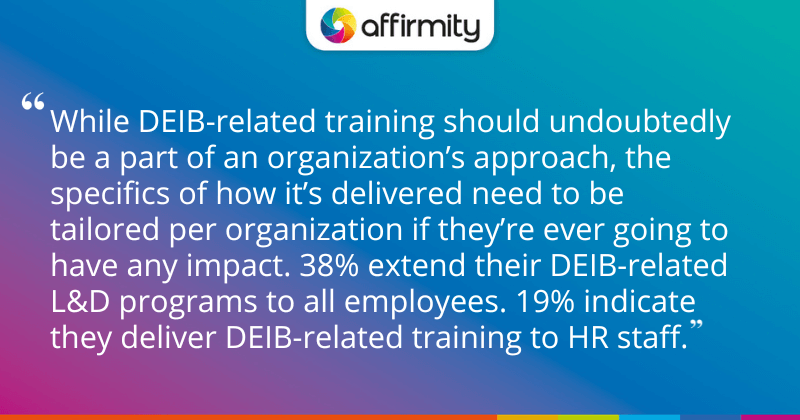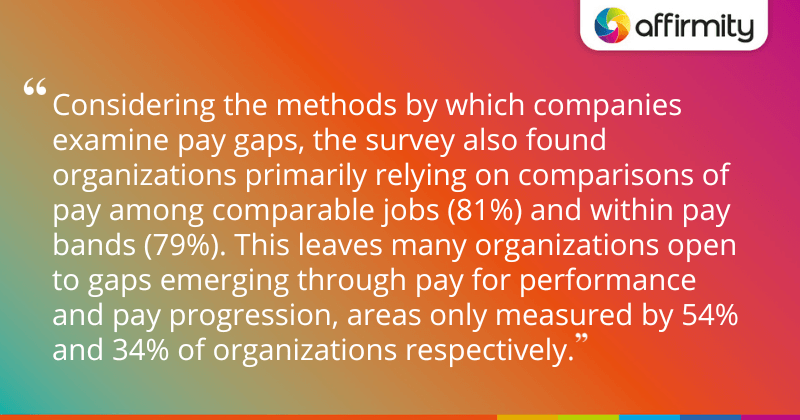Industry-wide progress on Diversity, Equity, Inclusion, and Belonging has once again been measured in the Affirmity-sponsored, HR Research Institute study ‘The Future of DEIB 2023’. In this blog post we’ve assembled five of the most interesting questions posed by the research, putting progress and best practices in the spotlight.
1) Have Organizations Made DEIB Progress Over the Last Year?
This year’s report reveals that when asked to rate the effectiveness of their organization’s DEIB initiatives on an ascending 10-point scale, just 6% of respondents would rate themselves as an 8 or above. Indeed, 52% gave their organization a rating of 4 or less.
These ratings offer little hope that DEIB has made great strides in the last year. In fact, the scores are actually marginally worse than 2022, when 9% of respondents gave themselves a rating of 8 and above, and 46% gave their effectiveness a score of 4 or less.
A lot of things could account for the fall. Obviously, there could be differences in those surveyed, but it may also tell a story of how awareness is growing that initiatives can be far more effective than they currently are—and worsening scores may indicate growing frustration with the current state of things.
The report makes a particularly appropriate observation in its analysis—the results do beg the question of how organizations know whether their initiatives are effective. And it’s certainly something later sections call into question…
ALSO ON THE BLOG | ‘How to Fairly and Safely Handle RIFs and Furloughs in an Economic Downturn’
2) Should HR Be Solely Responsible for DEIB?

The responsibility for DEIB falls with the HR department in many organizations: 25% say their HR department as a whole is responsible and 21% say it’s placed with a specific team or person within their HR department. Notably, 30% of all respondents say their organization doesn’t have a DEIB department, function, or representative—there’s naturally some variance based on size of business, but this still applies to 39% of mid-sized and 16% of large organizations.
Though DEIB within HR is common, the report calls this state of affairs into question. It later finds that most HR departments spend little time on DEIB issues, programs, and policies—81% say that their HR department spends less than 20% of its average workweek on DEIB. This is, as the report says, “hardly enough” considering “the complex nature of DEIB and the multi-faceted approach required to deal with DEIB issues.” The report later concludes that HR departments in DEIB leader organizations spend considerably more time per week on DEIB-related work.
3) Who Receives DEIB-Related Training and What Components Are Included?
While DEIB-related training should undoubtedly be a part of an organization’s approach, the specifics of how it’s delivered need to be tailored per organization if they’re ever going to have any impact.
HR.com’s survey found that only 38% extend their DEIB-related L&D programs to all employees. 19% indicated they delivered DEIB-related training to HR staff, 14% delivered to their senior executives, and 11% targeted all managers. HR.com posits that “this could definitely hamper the effectiveness of DEIB initiatives since DEIB awareness and involvement at all levels is the key to success.”
While not every part of the business needs to get every piece of training, and there’s a lot of value in providing highly focused courses to certain functions, it’s important to strive for full coverage.
When asked which DEIB L&D training they offered, unconscious bias training emerged as a clear stand-out, offered by 70% of organizations. Other common selections include:
- Inclusion awareness training (58%)
- Performance management training (50%)
- Conversations training (46%)
- Inclusive recruitment policies training (40%)
- Conflict resolution training (39%)
READ MORE ON HOW TO GET TRAINING RIGHT | ‘5 Ways to Protect Your Organization From Self-Sabotaging DE&I Training’

4) Is DEIB Today All Talk and No Action?
Under this provocatively framed heading, the report identifies some specific areas characteristic of action rather than talk. For example, it looks at the perception of whether DEIB initiatives are actually enhancing organizational performance:
- 57% agree or strongly agree that their current initiatives enhance the mission, vision, and values of their organization
- 50% said they agree or strongly agree that DEIB initiatives enhance organizational performance
- Only 22% stated that a DEIB framework was formally integrated into their business strategies
Concerningly, the report found that while there’s some effort to improve top-level representation (42% have one or more initiatives focused on this), managers are often not being encouraged to take an active role in enabling DEIB initiatives. The report suggests this is risking tokenism—projecting an image of a diverse organization without achieving real change at every level. Just one in ten organizations responding to the survey say that managers in their organization are rated based on their ability to reach DEIB goals.
The survey additionally looked at DEIB-enabling benefits and work arrangements, finding that:
- 82% offered paid time off
- 78% offered remote work options (with 69% offering flexible work options)
- 60% offered paid parental leave (and 49% offered benefits for domestic partners)
- 38% offered paid time off for non-statutory cultural/religious holidays
5) Do Organizations Understand and Prioritize Equitable Pay?

With recent pay data reporting legislation at federal, state, and local levels making pay equity a priority for many organizations, the report takes a look at how organizations are prioritizing pay equity beyond their legal obligations. It finds that only half of organizations say they are actively investing in understanding pay equity in their business and the wider industry to a high or very high-level extent.
Considering the methods by which companies examine pay gaps, the survey also found organizations primarily relying on comparisons of pay among comparable jobs (81%) and within pay bands (79%). This leaves many organizations open to gaps emerging through pay for performance and pay progression, areas only measured by 54% and 34% of organizations respectively. Only 16% opt for the thoroughness of a full regression analysis.
Taking a wider view of pay equity within organizational priority, the survey found:
- 21% do not believe pay equity is viewed as an organizational priority
- 32% believe the organization sees pay equity as one of their top five priorities
- 9% believe pay equity is the organization’s top priority
MORE ON PAY EQUITY | ‘Getting Pay Equity Analysis Off the Ground: The First 3 Steps of Your Process’
Answer Your DEIB Questions
These are just five issues uncovered in the Future of Diversity, Equity, Inclusion, and Belonging 2023 white paper. Across over 60 pages of analysis, you can expect many more questions to be covered, including:
- Are women and ethnic/racial minorities represented at leadership levels?
- How do organizations design and implement DEIB initiatives?
- How well are organizations measuring DEIB?
- What practices are linked to a greater chance of DEIB success?
- And more!
